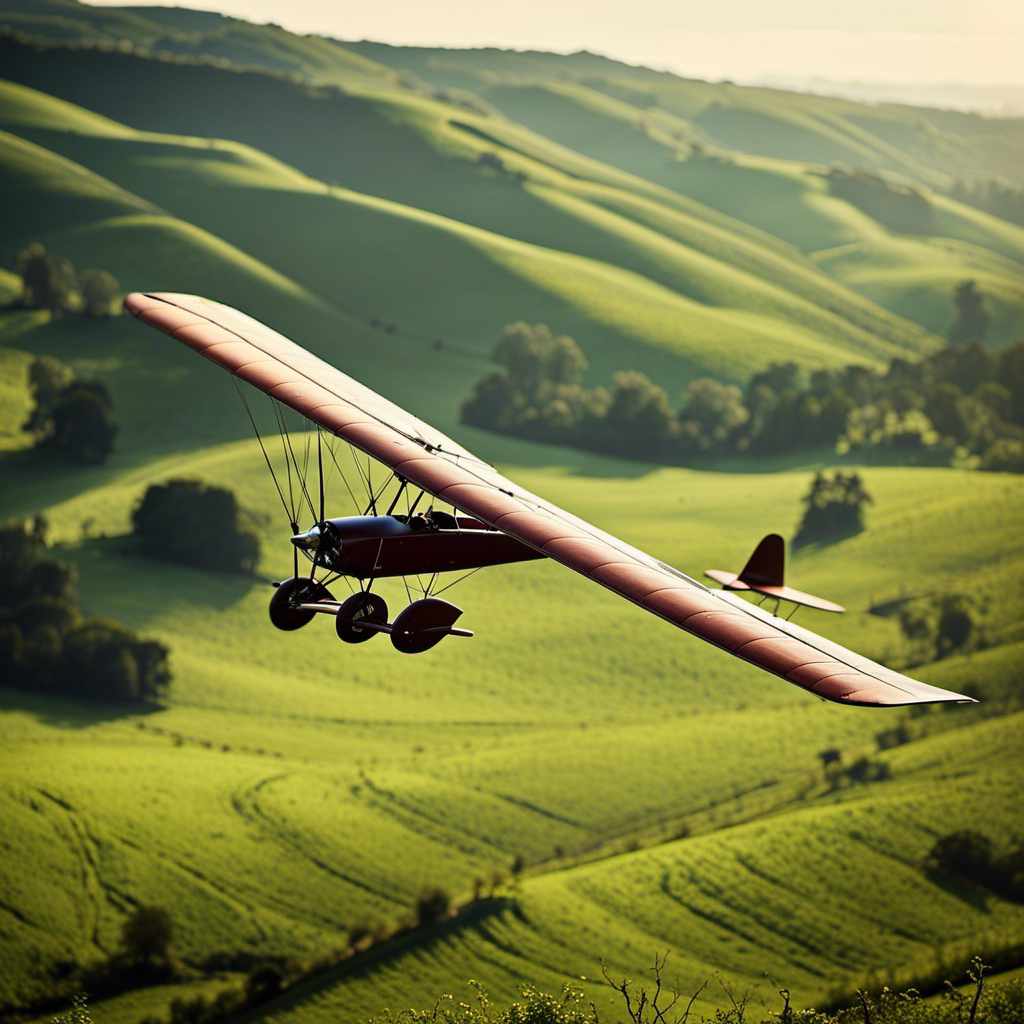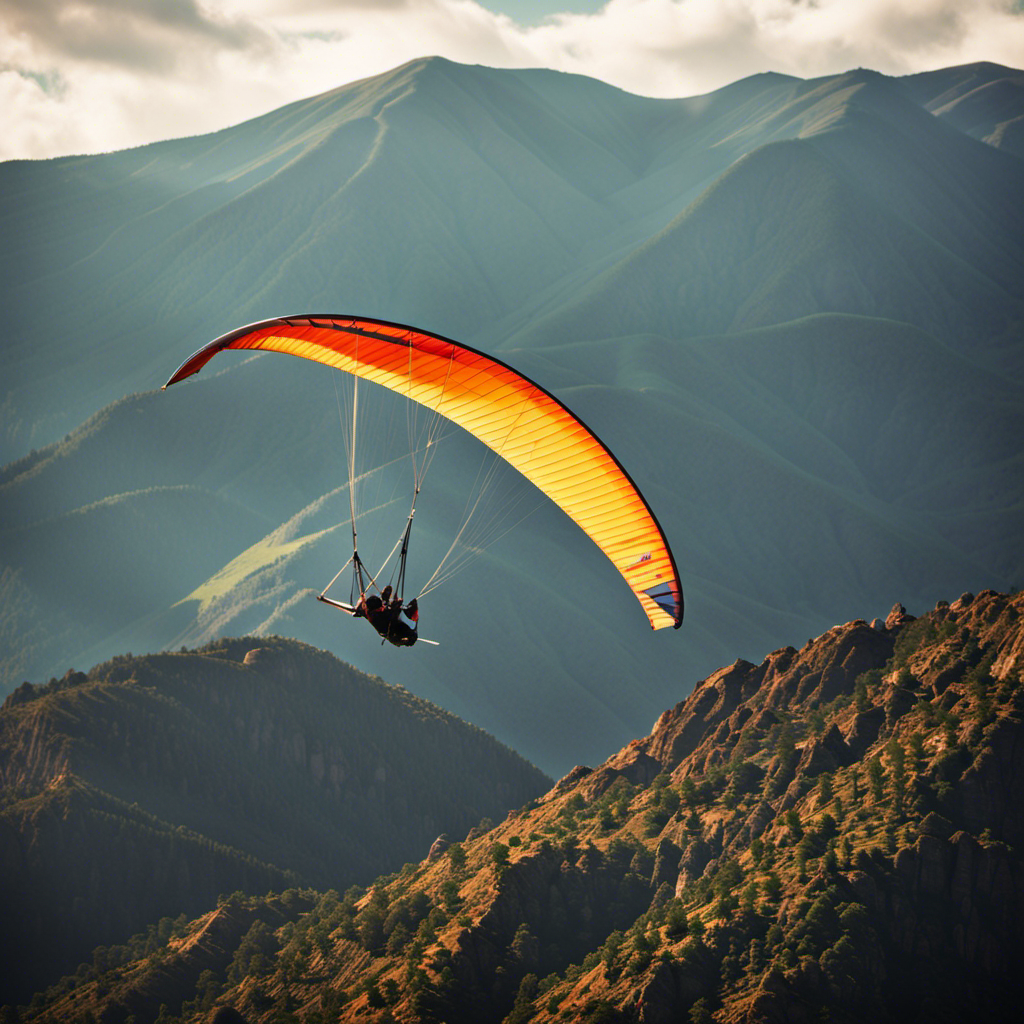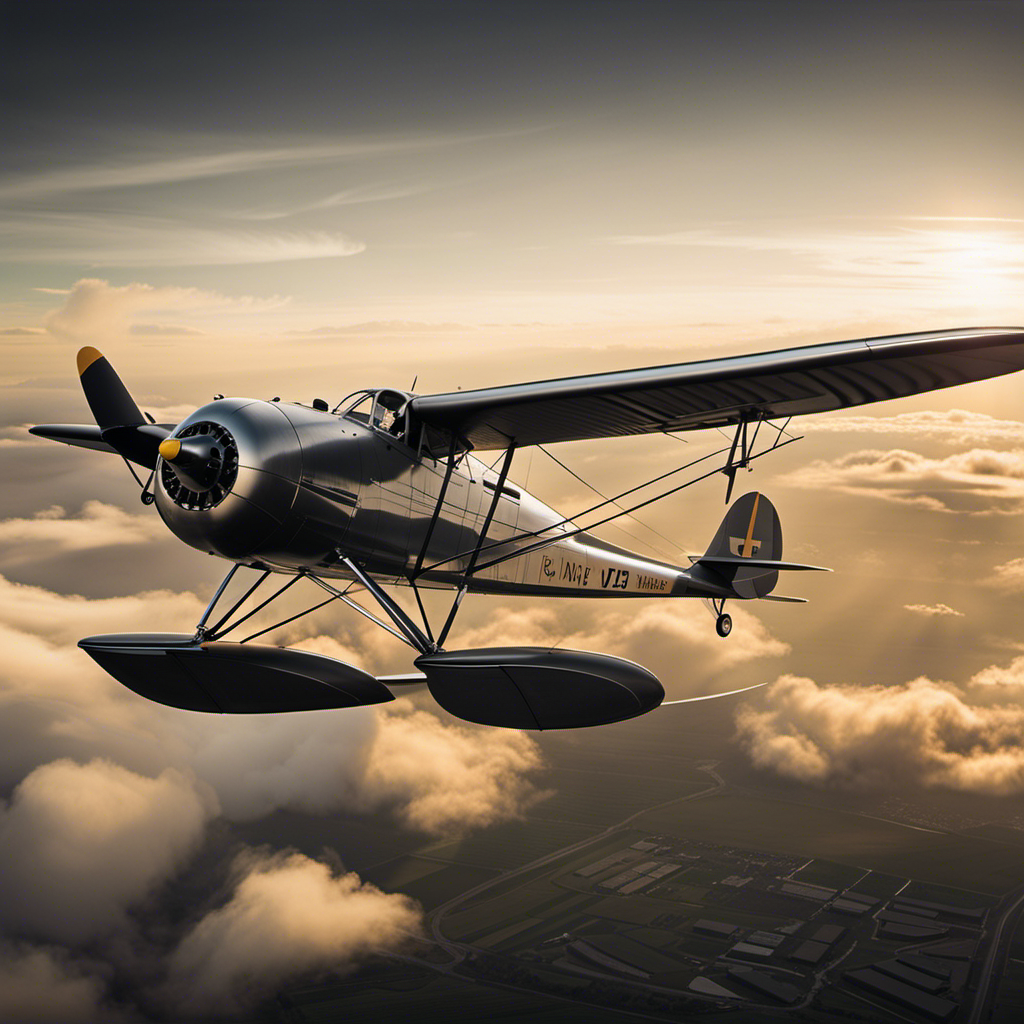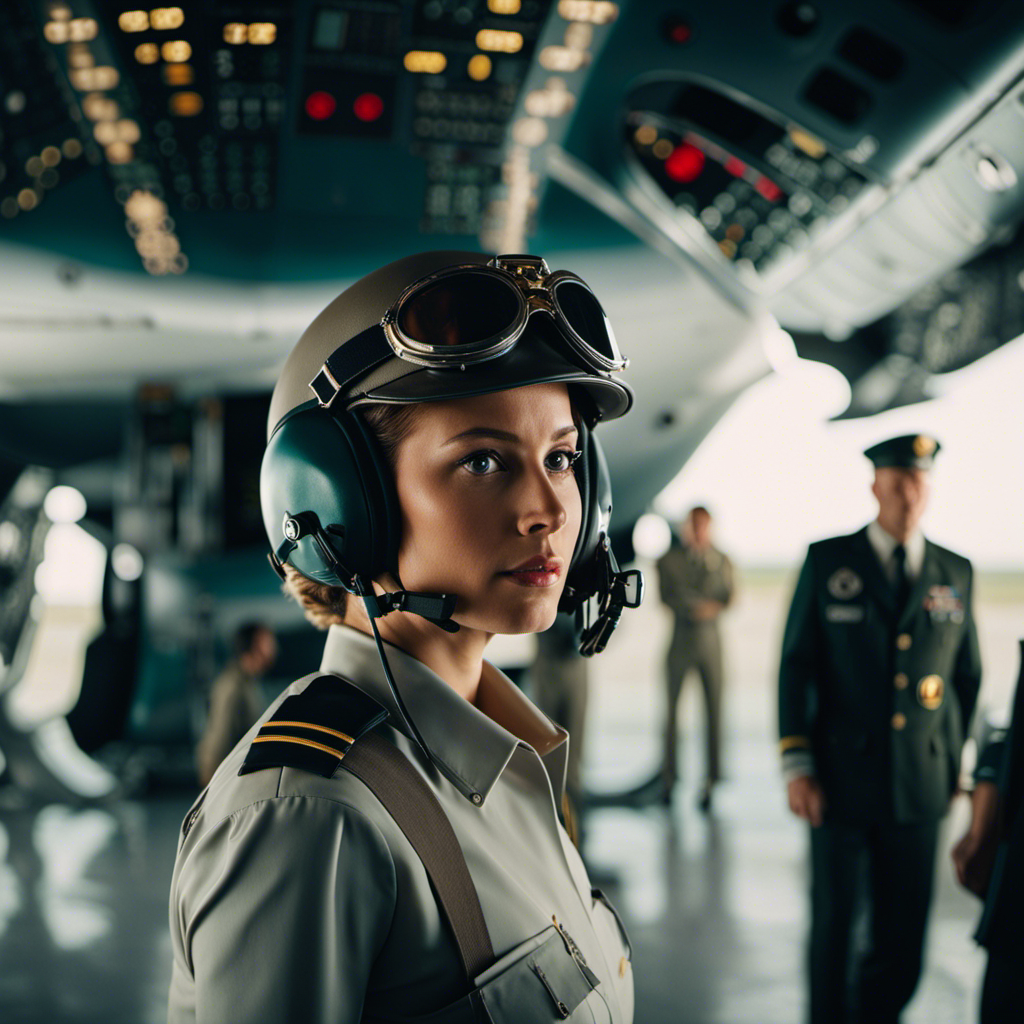I have always been fascinated by the history of aviation as someone who is deeply interested in the field. Can you provide me with the timeline for the invention of gliders?
This question takes us on a journey through time, exploring the early experiments in aviation and the birth of modern gliders. We will delve into the advancements in glider design, their role in World War I, and the thrilling world of gliding competitions and records.
Join me as we uncover the evolution of gliders, from their humble beginnings to their promising future in sustainable aviation.
Key Takeaways
- Gliders were invented as a result of early aviation experiments.
- Sir George Cayley and Otto Lilienthal played crucial roles in the development of gliders.
- Lilienthal made significant contributions to glider design and was the first person to make controlled, sustained flights with a glider.
- Advancements in wing shape, control mechanisms, and materials paved the way for modern gliders.
Early Experiments in Aviation
You’ll be interested to know that early experiments in aviation paved the way for the invention of gliders.
In the late 18th century, early aviation pioneers began their quest to conquer the skies. One such pioneer was Sir George Cayley, considered the father of modern aviation. In the early 1800s, Cayley conducted extensive flight experimentation and made significant contributions to the understanding of aerodynamics. He designed and built various glider prototypes, which laid the foundation for future advancements in flight.
Another notable figure in early aviation was Otto Lilienthal, a German pioneer who conducted extensive research on aerodynamics and developed successful glider designs. Lilienthal’s studies of bird flight and his glider experiments provided valuable insights into lift and control mechanisms.
These early aviation pioneers, through their relentless pursuit of flight, played a crucial role in the development of gliders. Their experiments and achievements set the stage for the birth of modern gliders, which marked significant advancements in aviation technology and opened up new possibilities for human flight.
The Birth of Modern Gliders
If you want to learn about the birth of modern gliders, it’s important to understand their history and development. The birth of modern gliders can be traced back to the early aviation experiments of the late 19th and early 20th centuries. During this time, inventors and aviation pioneers were pushing the boundaries of flight, seeking ways to soar through the skies like birds. It was during this period that the concept of gliding, or flying without an engine, started to take shape.
One of the key figures in the birth of modern gliders was Otto Lilienthal, a German aviation pioneer. Lilienthal conducted extensive research on the principles of flight and made significant contributions to glider design. He was the first person to make controlled, sustained flights with a glider, and his work laid the foundation for future advancements in glider technology.
Lilienthal’s success inspired other inventors and aviators to further refine and improve glider designs. This led to advancements in areas such as wing shape and structure, control mechanisms, and materials used. These developments paved the way for the modern gliders we see today.
As glider technology continued to evolve, new designs and innovations emerged, leading to even greater efficiency and performance. The advancements in glider design brought about significant improvements in terms of glide ratio, stability, and maneuverability.
In the subsequent section, we will explore the fascinating advancements in glider design that have taken place over the years.
Advancements in Glider Design
After Lilienthal’s pioneering flights, glider design underwent significant advancements, leading to improvements in glide ratio, stability, and maneuverability. Engineers and designers around the world began experimenting with different wing shapes, control mechanisms, and materials to enhance the performance of gliders.
One of the key advancements in glider design was the development of the airfoil shape, which allowed for better lift and reduced drag. This breakthrough led to increased glide ratios, enabling gliders to stay aloft for longer periods of time. Additionally, designers focused on improving stability by incorporating features such as tail surfaces and weight distribution systems. These advancements made gliders more controllable and safer to fly.
Another aspect of glider design that saw advancements was the construction materials used. Traditional wooden frameworks were replaced with lightweight, yet strong, materials like aluminum and composite materials. This not only reduced the weight of the gliders but also increased their strength and durability. As a result, gliders became more robust and capable of withstanding the stresses of flight.
Overall, the advancements in glider design during this period paved the way for the next step in the evolution of gliders – their use in warfare. Gliders in World War I played a crucial role in reconnaissance and troop transportation, taking advantage of the advancements made in glider design to support military operations.
Gliders in World War I
The use of gliders in World War I revolutionized reconnaissance and troop transportation, thanks to the advancements in glider design. Gliders played a crucial role in military operations during the war, providing a silent and efficient means of transporting troops and supplies behind enemy lines. Glider pilots in World War I were highly skilled and brave individuals who navigated these fragile aircraft with precision and skill.
Glider pilots were tasked with various missions, including infiltrating enemy lines to gather intelligence, transporting troops and supplies to remote locations, and aiding in the evacuation of wounded soldiers. These silent aircraft allowed for stealthy operations, avoiding detection by enemy forces. Gliders were particularly effective in areas with rough or uneven terrain, where traditional aircraft could not easily land.
The use of gliders in World War I paved the way for future military operations involving airborne assaults. The success and effectiveness of gliders during the war led to further advancements in glider technology and the development of larger and more sophisticated glider models.
In the subsequent section, we will explore the world of gliding competitions and records, showcasing the continued evolution and popularity of glider aviation.
Gliding Competitions and Records
You can discover the thrilling world of gliding competitions and records, showcasing the ongoing evolution and popularity of glider aviation. Gliding techniques have advanced significantly over the years, allowing pilots to achieve incredible feats of skill and endurance.
Here are some fascinating aspects of gliding competitions and the famous pilots who have pushed the boundaries of what is possible in the sky:
-
Aerobatics: Witness gravity-defying maneuvers as glider pilots perform loops, rolls, and spins with precision and grace.
-
Cross-country racing: Experience the excitement of gliders racing against the clock to cover long distances, utilizing clever tactics and exploiting rising air currents.
-
Altitude records: Marvel at the achievements of glider pilots who have reached astonishing heights, soaring above the clouds and pushing the limits of human flight.
-
Duration records: Be amazed by the incredible stamina of glider pilots who have stayed airborne for hours, even days, relying solely on the skillful use of thermals and ridge lift.
-
Distance records: Discover the extraordinary journeys undertaken by glider pilots as they fly across vast stretches of land, sometimes covering hundreds of kilometers in a single flight.
These gliding competitions and the accomplishments of famous gliding pilots have captivated aviation enthusiasts worldwide, inspiring the next generation of glider pilots to continue pushing the boundaries of what is possible in the sky.
As we delve into the gliders of the 20th century, we will explore the technological advancements that have shaped the modern glider industry.
Gliders in the 20th Century
In the 20th century, gliders played a significant role in civilian aviation, leading to important technological advancements.
Gliders were increasingly used for various purposes, such as recreational flying, transportation, and even military operations.
These advancements in glider technology paved the way for the development of modern aircraft and contributed to the growth of the aviation industry.
Gliders in Civilian Aviation
If you want to learn about gliders in civilian aviation, the Wright brothers are credited with inventing the first successful glider in 1902.
Glider manufacturing has come a long way since then, with advancements in technology and design. The process of manufacturing gliders involves careful construction and assembly of lightweight materials to ensure optimal performance.
Glider aerodynamics play a crucial role in achieving lift and maintaining stability during flight. The shape of the wings, control surfaces, and overall design of the glider are carefully optimized to minimize drag and maximize efficiency.
Over the years, technological advancements have further improved glider performance, including the use of composite materials, advanced wing profiles, and more sophisticated control systems. These advancements have allowed gliders to achieve longer flight times, higher altitudes, and greater maneuverability, making them an important part of modern civilian aviation.
Technological Advancements
With the development of composite materials and advanced wing profiles, glider technology has significantly improved.
Materials innovation has played a crucial role in enhancing the performance and efficiency of gliders. The use of composite materials, such as carbon fiber, has allowed for stronger and lighter glider structures, resulting in increased maneuverability and longer flight durations.
Advanced wing profiles, such as the laminar flow airfoil, have also contributed to improved aerodynamic efficiency and reduced drag.
These technological advancements have paved the way for the future of aviation, where gliders are expected to play a significant role. With ongoing research and development, gliders in the 21st century are poised to offer even greater performance, efficiency, and sustainability, making them an attractive option for both recreational and commercial applications.
Gliders in the 21st Century
You can’t deny how popular gliders have become in the 21st century. With advancements in technology, glider sustainability and performance have seen significant improvements.
Glider sustainability has become a key focus in recent years. Manufacturers are now designing gliders with more environmentally friendly materials, such as carbon fiber, which not only reduces weight but also increases fuel efficiency. Additionally, gliders are being equipped with more efficient engines and energy recovery systems, allowing for longer flight times and reduced emissions.
In terms of performance, gliders have come a long way. Aerodynamic advancements, such as improved wing designs and smoother surfaces, have enhanced glider performance, resulting in higher speeds and better maneuverability. Furthermore, advancements in avionics systems have made navigation and communication more precise and reliable. Pilots now have access to real-time weather updates and advanced flight planning software, improving safety and efficiency.
As we delve into the topic of glider safety and training, it is important to recognize the significant strides that have been made in glider sustainability and performance. These advancements have paved the way for safer and more enjoyable gliding experiences, allowing pilots to push the boundaries of this exhilarating sport.
Glider Safety and Training
Transitioning from the advancements of gliders in the 21st century, it is crucial to address the importance of glider safety and training. In order to ensure a smooth and secure flight, proper maintenance and understanding of glider performance are paramount. Here are some key aspects to consider:
-
Regular Inspections: Gliders must undergo routine inspections to identify any potential issues or wear and tear. This includes checking the airframe, control surfaces, and landing gear, as well as inspecting the canopy and cockpit for any signs of damage.
-
Flight Manual Familiarization: Pilots should thoroughly study the glider’s flight manual to gain a comprehensive understanding of its specifications, limitations, and emergency procedures. This knowledge is vital for safe and efficient flying.
-
Pre-flight Checks: Before each flight, pilots should conduct a thorough pre-flight check to ensure that all systems are functioning properly. This includes inspecting the control surfaces, verifying the integrity of the towline or winch cable, and confirming the availability of necessary equipment such as parachutes and emergency supplies.
-
Ongoing Training: Regular training sessions and refresher courses are essential for maintaining proficiency and improving skills. Pilots should stay up-to-date with the latest techniques, regulations, and safety protocols to ensure safe and enjoyable glider flights.
By adhering to these maintenance practices and prioritizing training, glider enthusiasts can enhance their safety and ensure optimal performance.
Now, let us delve into the fascinating realm of gliders and sustainable aviation.
Gliders and Sustainable Aviation
To understand the impact of gliders on sustainable aviation, it’s important to consider their energy-efficient designs and minimal carbon emissions. Gliders are uniquely designed aircraft that rely solely on natural forces, such as wind and thermals, to stay aloft. Unlike traditional powered aircraft that consume fuel and emit greenhouse gases, gliders offer a more environmentally friendly alternative. This makes them a promising solution to the sustainability challenges faced by the aviation industry.
Gliders have a significantly lower environmental impact compared to powered aircraft. They produce no emissions during flight, resulting in zero carbon footprint. Additionally, their energy-efficient designs allow them to soar through the sky with minimal energy consumption. By harnessing the power of nature, gliders provide a sustainable way to enjoy the freedom of flight.
Looking towards the future of gliders, advancements in technology and materials will continue to improve their performance and sustainability. With the development of lightweight materials and more efficient aerodynamics, gliders will become even more energy-efficient and environmentally friendly. These advancements will not only benefit the aviation industry but also contribute to global efforts in reducing carbon emissions and mitigating climate change. As we move forward, the future of gliders holds great promise for a greener and more sustainable aviation industry.
The Future of Gliders
Advances in materials and technology have revolutionized the field of aviation, opening up new possibilities for gliders and other aircraft. These innovations have allowed for the development of stronger, lighter, and more efficient materials that enhance performance and increase safety.
With these advancements, the potential applications in aviation are vast. Improved glider performance and longer flight durations are just a few of the benefits. Additionally, these advancements have paved the way for the development of electric and autonomous aircraft, which could revolutionize the industry even further.
Advances in Materials and Technology
During the 19th century, gliders were invented as a result of advancements in materials and technology.
The development of lightweight and durable materials such as bamboo, fabric, and wire allowed for the construction of more sophisticated glider designs.
The introduction of new technologies, such as wind tunnels and mathematical modeling, also played a significant role in improving glider performance.
These advancements in glider materials and technology led to the design of more efficient and maneuverable gliders, with increased lift and reduced drag.
The impact of technology on glider design cannot be overstated, as it opened up new possibilities for longer flights and greater control.
With these advancements, gliders became a stepping stone towards the development of powered aircraft, paving the way for the potential applications in aviation.
Potential Applications in Aviation
If you’re interested in aviation, you’ll be fascinated by the potential applications that gliders have paved the way for. Gliders, with their ability to fly without an engine, have found various uses beyond recreational flying. One of the key areas where gliders have made a significant impact is in emergency response. Due to their ability to stay aloft for extended periods, gliders can be used for search and rescue missions, providing a cost-effective and efficient means of locating lost or injured individuals. Additionally, gliders have proven invaluable in scientific research. Their silent flight and maneuverability allow scientists to study wildlife and collect data without disturbing the natural environment. Gliders have truly revolutionized the field of aviation, opening up new possibilities and expanding our understanding of the world around us.
| Applications in Emergency Response | Gliders in Scientific Research |
|---|---|
| Search and rescue missions | Wildlife studies |
| Cost-effective solution | Data collection |
| Efficient locating of individuals | Minimal disturbance |
| Extended flight capabilities | Environmental research |
| Versatile and adaptable | Advancements in knowledge |
Frequently Asked Questions
What are some notable glider records that have been set in the 21st century?
In the 21st century, glider competitions have witnessed remarkable achievements in terms of glider flight distances. Pilots have pushed the boundaries, achieving impressive records and showcasing the advancements in glider technology and piloting skills.
How long does it typically take to receive glider pilot training and become certified?
Glider pilot training duration varies, but typically takes a few months. The meticulous process involves ground school, flight instruction, and passing exams. Once completed, glider certification is obtained, allowing one to soar through the skies with confidence.
What safety measures are in place to ensure the safety of glider pilots and passengers?
Safety regulations and training requirements are in place to ensure the safety of glider pilots and passengers. These measures include regular inspections, pilot certification, emergency procedures training, and adherence to airspace rules.
How have advancements in technology impacted glider design in the 20th century?
Advancements in technology in the 20th century have revolutionized glider design. From aerodynamic improvements to lightweight materials, these advancements have made gliders safer, more efficient, and capable of reaching greater distances. It’s truly astounding what technology can achieve.
Are gliders environmentally friendly and sustainable compared to other forms of aviation?
Gliders are environmentally friendly and sustainable compared to other forms of aviation. They have minimal environmental impact and are fuel-efficient since they rely on natural forces like wind and thermals for propulsion, rather than burning fossil fuels.
Conclusion
In conclusion, gliders have come a long way since they were first invented. They have undergone advancements in design and have become a remarkable mode of sustainable aviation. From early experiments in aviation to the present day, gliders have played significant roles in various areas. They have been used in World War I, participated in gliding competitions, and set records. Looking ahead, the safety and training of glider pilots will remain a top priority. It is essential to ensure that gliders continue to be a safe and enjoyable activity. With their graceful flight and silent glide, gliders truly soar like birds, reminding us of the boundless possibilities of human ingenuity.
With a heart that soars as high as the skies, Aria, affectionately known as “Skylark,” is the driving force behind Soaring Skyways. Her journey into the gliding world began as a young dreamer gazing up at the soaring birds, yearning to experience the weightlessness and freedom they embodied. With years of experience both in the cockpit and behind the scenes, Aria’s commitment to the gliding community is unwavering.










